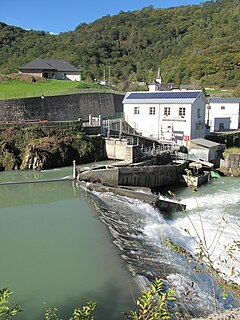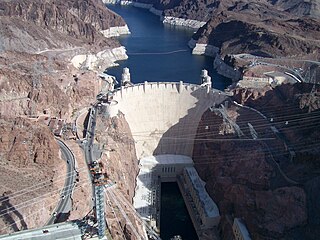With seventy percent of Colombia's power generation, hydroelectric power is a very important national energy source. The total large hydropower potential for Colombia is estimated at 93GW, with an additional 25GW of small hydropower (<20MW). However, the potential for large hydropower faces difficulties, as the best sites have already been developed, also due to the escalating environmental and social costs associated with large dams, and the likely impacts of climate change and climate variability on the hydrological regime of the country (drastic increases in surface temperature in the Andes, changes in precipitation patterns, and increases in the intensity and frequency of El Niño-Southern Oscillation (ENSO) signals driving prolonged periods of drought). [1]
The large hydropower plants to be built in Colombia up to 2010 are listed below: [1]

Small hydro is the development of hydroelectric power on a scale suitable for local community and industry, or to contribute to distributed generation in a regional electricity grid. Exact definitions vary, but a "small hydro" project is less than 50 megawatts (MW), and can be further subdivide by scale into "mini" (<1MW), "micro" (<100 kW), "pico" (<10 kW). In contrast many hydroelectric projects are of enormous size, such as the generating plant at the Three Gorges Dam at 22,500 megawatts or the vast multiple projects of the Tennessee Valley Authority.

Hydroelectricity, or hydroelectric power, is electricity generated from hydropower. Hydropower supplies one sixth of the world's electricity, almost 4500 TWh in 2020, which is more than all other renewable sources combined and also more than nuclear power.

As of 2018, renewable energy accounted for 79% of the domestically produced electricity used in Brazil.
Colombia has 28.1 Megawatt installed capacity of renewable energy, consisting mainly of wind power. This supplies 1% of the country's needs. The country has significant wind and solar resources that remain largely unexploited. According to a study by the World Bank’s Energy Sector Management Assistance Program (ESMAP), exploitation of the country’s significant wind potential alone could cover more than the country’s current total energy needs.

China is the world's leading country in electricity production from renewable energy sources, with over triple the generation of the second-ranking country, the United States. China's renewable energy sector is growing faster than its fossil fuels and nuclear power capacity, and is expected to contribute 43 percent of global renewable capacity growth. China's total renewable energy capacity exceeded 1,000GW in 2021, accounting for 43.5 per cent of the country's total power generation capacity, 10.2 percentage points higher than in 2015. The country aims to have 80 per cent of its total energy mix come from non-fossil fuel sources by 2060, and achieve a combined 1,200GW of solar and wind capacity by 2030.

China's electric power industry is the world's largest electricity producer, passing the United States in 2011 after rapid growth since the early 1990s. In 2019, China produced more electricity than the next three countries—U.S., India, and Russia—combined.

India is world's 3rd largest consumer of electricity and world's 3rd largest renewable energy producer with 40% of energy capacity installed in the year 2022 coming from renewable sources. Ernst & Young's (EY) 2021 Renewable Energy Country Attractiveness Index (RECAI) ranked India 3rd behind USA and China. In November 2021, India had a renewable energy capacity of 150 GW consisting of solar, wind, small hydro power, bio-mass, large hydro, and nuclear. India has committed for a goal of 500 GW renewable energy capacity by 2030.
Energy in Ethiopia is energy and electricity production, consumption, transport, exportation, and importation in Ethiopia.

Hydroelectricity is, as of 2019, the second-largest renewable source of energy in both generation and nominal capacity in the United States. In 2021, hydroelectric power produced 31.5% of the total renewable electricity, and 6.3% of the total U.S. electricity.

Renewable energy in Russia mainly consists of hydroelectric energy. In 2010, the country was the sixth largest producer of renewable energy in the world, although it was 56th when hydroelectric energy was not taken into account. Some 179 TWh of Russia's energy production came from renewable energy sources, out of a total economically feasible potential of 1823 TWh. 16% of Russia's electricity was generated from hydropower, and less than 1% was generated from all other renewable energy sources combined. Roughly 68% of Russia's electricity was generated from thermal power and 16% from nuclear power.

As of 2018, hydroelectric power stations in the United Kingdom accounted for 1.87 GW of installed electrical generating capacity, being 2.2% of the UK's total generating capacity and 4.2% of UK's renewable energy generating capacity. This includes four conventional hydroelectric power stations and run-of-river schemes for which annual electricity production is approximately 5,000 GWh, being about 1.3% of the UK's total electricity production. There are also pumped-storage hydroelectric power stations providing a further 2.8 GW of installed electrical generating capacity, and contributing up to 4,075 GWh of peak demand electricity annually.

Hydroelectricity is a major source of electricity in Turkey, due to its mountainous landscape and many rivers. The country's main river basins are those of the Euphrates and the Tigris. Over 700 hydropower plants have been built, and hydroelectricity makes up about 30% of the country's electricity generating capacity. Annual generation varies greatly, and in rainy years lots of hydroelectric power can be generated. Government policies have generally supported dam construction, but some dams are controversial in neighbouring countries, while others raise concerns about damage to the environment and wildlife of Turkey.

Ethiopia generates most of its electricity from renewable energy, mainly hydropower.

Renewable energy in Turkey is mostly hydroelectricity, geothermal energy and solar energy. Although sun and wind could supply plenty of energy in Turkey, hydropower is the only renewable energy which is fully exploited, averaging about a fifth of national electricity supply. However in drought years much less electricity is generated by hydro. Over half of capacity is renewables, and it is estimated that over half of generation could be from renewables by 2026, but Turkey has invested less in solar and wind power than similar Mediterranean countries. Turkey lacks a renewable energy plan beyond 2023 which includes transport, industry, heating and cooling as well as electricity generation. More renewable energy could be used to reduce the nation's greenhouse gas emissions, and thus avoid paying other countries' carbon tariffs. Turkey is a net exporter of wind power equipment, but a net importer of solar power equipment. Total non-hydro renewables overtook hydro in 2021. Solar is expected to overtake wind before 2030.

Hydroelectricity is currently China's largest renewable energy source and the second overall after coal. China's installed hydroelectric capacity in 2015 was 356 GW, up from 172 GW in 2009, including 23 GW of pumped storage hydroelectricity capacity. According to the International Hydropower Association China is the worlds largest producer of hydroelectricity in 2021. In 2018, hydropower generated 1,232 TWh of power, accounting for roughly 18% of China's total electricity generation.
Myanmar had a total primary energy supply (TPES) of 16.57 Mtoe in 2013. Electricity consumption was 8.71 TWh. 65% of the primary energy supply consists of biomass energy, used almost exclusively (97%) in the residential sector. Myanmar’s energy consumption per capita is one of the lowest in Southeast Asia due to the low electrification rate and a widespread poverty. An estimated 65% of the population is not connected to the national grid. Energy consumption is growing rapidly, however, with an average annual growth rate of 3.3% from 2000 to 2007.
In 2013, renewable energy provided 26.44% of the total electricity in the Philippines and 19,903 gigawatt-hours (GWh) of electrical energy out of a total demand of 75,266 gigawatt-hours. The Philippines is a net importer of fossil fuels. For the sake of energy security, there is momentum to develop renewable energy sources. The types available include hydropower, geothermal power, wind power, solar power and biomass power. The government of the Philippines has legislated a number of policies in order to increase the use of renewable energy by the country.
There is enormous potential for renewable energy in Kazakhstan, particularly from wind and small hydropower plants. The Republic of Kazakhstan has the potential to generate 10 times as much power as it currently needs from wind energy alone. But renewable energy accounts for just 0.6 percent of all power installations. Of that, 95 percent comes from small hydropower projects. The main barriers to investment in renewable energy are relatively high financing costs and an absence of uniform feed-in tariffs for electricity from renewable sources. The amount and duration of renewable energy feed-in tariffs are separately evaluated for each project, based on feasibility studies and project-specific generation costs. Power from wind, solar, biomass and water up to 35 MW, plus geothermal sources, are eligible for the tariff and transmission companies are required to purchase the energy of renewable energy producers. An amendment that introduces and clarifies technology-specific tariffs is now being prepared. It is expected to be adopted by Parliament by the end of 2014. In addition, the World Bank's Ease of Doing Business indicator shows the country to be relatively investor-friendly, ranking it in 10th position for investor protection.
Vietnam utilizes four main sources of renewable energy: hydroelectricity, wind power, solar power and biomass. By the end of 2018, hydropower was the largest source of renewable energy, contributing about 40% to the total national electricity capacity. Other renewable energy sources accounted for 2.1% of the total capacity of the whole system in mid-2019. The commercial biomass electricity generation is currently slow and limited to valorizing bagasse only, but the stream of forest products, agricultural and municipal waste is increasing. The government is studying a renewable portfolio standard that could promote this energy source.

By the end of 2016 Austria already fulfilled their EU Renewables Directive goal for the year 2020. By 2016 renewable energies accounted to 33.5% of the final energy consumption in all sectors. The renewable energy sector is also accountable for hosting 41,591 jobs and creating a revenue of 7,219 million euros in 2016.